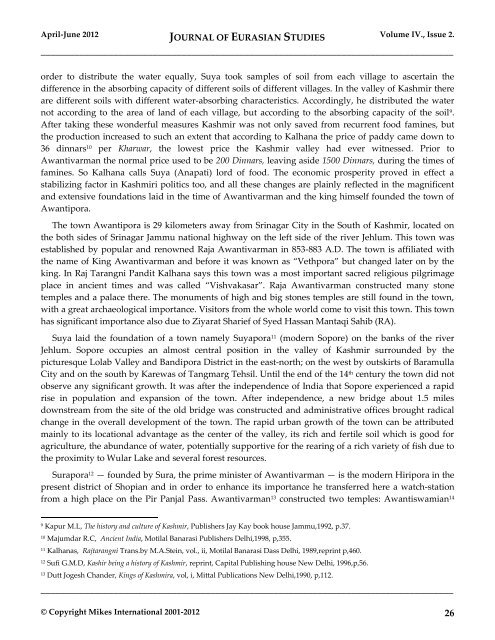You also want an ePaper? Increase the reach of your titles
YUMPU automatically turns print PDFs into web optimized ePapers that Google loves.
April-June 2012 JOURNAL OF EURASIAN STUDIES Volume IV., Issue 2.<br />
_____________________________________________________________________________________<br />
order to distribute the water equally, Suya took samples <strong>of</strong> soil from each village to ascertain the<br />
difference in the absorbing capacity <strong>of</strong> different soils <strong>of</strong> different villages. In the valley <strong>of</strong> Kashmir there<br />
are different soils with different water-absorbing characteristics. Accordingly, he distributed the water<br />
not according to the area <strong>of</strong> land <strong>of</strong> each village, but according to the absorbing capacity <strong>of</strong> the soil 9 .<br />
After taking these wonderful measures Kashmir was not only saved from recurrent food famines, but<br />
the production increased to such an extent that according to Kalhana the price <strong>of</strong> paddy came down to<br />
36 dinnars 10 per Kharwar, the lowest price the Kashmir valley had ever witnessed. Prior to<br />
Awantivarman the normal price used to be 200 Dinnars, leaving aside 1500 Dinnars, during the times <strong>of</strong><br />
famines. So Kalhana calls Suya (Anapati) lord <strong>of</strong> food. The economic prosperity proved in effect a<br />
stabilizing factor in Kashmiri politics too, and all these changes are plainly reflected in the magnificent<br />
and extensive foundations laid in the time <strong>of</strong> Awantivarman and the king himself founded the town <strong>of</strong><br />
Awantipora.<br />
The town Awantipora is 29 kilometers away from Srinagar City in the South <strong>of</strong> Kashmir, located on<br />
the both sides <strong>of</strong> Srinagar Jammu national highway on the left side <strong>of</strong> the river Jehlum. This town was<br />
established by popular and renowned Raja Awantivarman in 853-883 A.D. The town is affiliated with<br />
the name <strong>of</strong> King Awantivarman and before it was known as “Vethpora” but changed later on by the<br />
king. In Raj Tarangni Pandit Kalhana says this town was a most important sacred religious pilgrimage<br />
place in ancient times and was called “Vishvakasar”. Raja Awantivarman constructed many stone<br />
temples and a palace there. The monuments <strong>of</strong> high and big stones temples are still found in the town,<br />
with a great archaeological importance. Visitors from the whole world come to visit this town. This town<br />
has significant importance also due to Ziyarat Sharief <strong>of</strong> Syed Hassan Mantaqi Sahib (RA).<br />
Suya laid the foundation <strong>of</strong> a town namely Suyapora 11 (modern Sopore) on the banks <strong>of</strong> the river<br />
Jehlum. Sopore occupies an almost central position in the valley <strong>of</strong> Kashmir surrounded by the<br />
picturesque Lolab Valley and Bandipora District in the east-north; on the west by outskirts <strong>of</strong> Baramulla<br />
City and on the south by Karewas <strong>of</strong> Tangmarg Tehsil. Until the end <strong>of</strong> the 14 th century the town did not<br />
observe any significant growth. It was after the independence <strong>of</strong> India that Sopore experienced a rapid<br />
rise in population and expansion <strong>of</strong> the town. After independence, a new bridge about 1.5 miles<br />
downstream from the site <strong>of</strong> the old bridge was constructed and administrative <strong>of</strong>fices brought radical<br />
change in the overall development <strong>of</strong> the town. The rapid urban growth <strong>of</strong> the town can be attributed<br />
mainly to its locational advantage as the center <strong>of</strong> the valley, its rich and fertile soil which is good for<br />
agriculture, the abundance <strong>of</strong> water, potentially supportive for the rearing <strong>of</strong> a rich variety <strong>of</strong> fish due to<br />
the proximity to Wular Lake and several forest resources.<br />
Surapora 12 — founded by Sura, the prime minister <strong>of</strong> Awantivarman — is the modern Hiripora in the<br />
present district <strong>of</strong> Shopian and in order to enhance its importance he transferred here a watch-station<br />
from a high place on the Pir Panjal Pass. Awantivarman 13 constructed two temples: Awantiswamian 14<br />
9 Kapur M.L, The history and culture <strong>of</strong> Kashmir, Publishers Jay Kay book house Jammu,1992, p.37.<br />
10 Majumdar R.C, Ancient India, Motilal Banarasi Publishers Delhi,1998, p,355.<br />
11 Kalhanas, Rajtarangni Trans.by M.A.Stein, vol., ii, Motilal Banarasi Dass Delhi, 1989,reprint p,460.<br />
12 Sufi G.M.D, Kashir being a history <strong>of</strong> Kashmir, reprint, Capital Publishing house New Delhi, 1996,p,56.<br />
13 Dutt Jogesh Chander, Kings <strong>of</strong> Kashmira, vol, i, Mittal Publications New Delhi,1990, p,112.<br />
_____________________________________________________________________________________<br />
© Copyright Mikes International 2001-2012 26
















